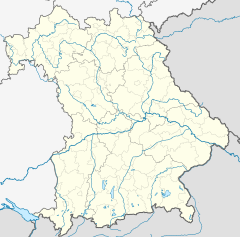| Neuschwanstein Castle | |
|---|---|
 Neuschwanstein Castle in 2013, looking northeast | |
Location within Germany | |
 | |
| General information | |
| Architectural style | Romanesque Revival |
| Location | Hohenschwangau, Germany |
| Coordinates | 47°33′27″N 10°44′58″E / 47.55750°N 10.74944°E |
| Construction started | 5 September 1869 |
| Completed | c. 1886 (opened) |
| Owner | Bavarian Palace Department |
| Design and construction | |
| Architect(s) | Eduard Riedel |
| Civil engineer | Eduard Riedel, Georg von Dollmann, Julius Hofmann |
| Other designers | Ludwig II, Christian Jank |
Neuschwanstein Castle (German: Schloss Neuschwanstein, pronounced [ˈʃlɔs nɔʏˈʃvaːnʃtaɪn]; Southern Bavarian: Schloss Neischwanstoa) is a 19th-century historicist palace on a rugged hill of the foothills of the Alps in the very south of Germany. It is located in the Swabia region of Bavaria, in the municipality of Schwangau, above the incorporated village of Hohenschwangau, which is also the location of Hohenschwangau Castle. The closest larger town is Füssen. The castle stands above the narrow gorge of the Pöllat stream, east of the Alpsee and Schwansee lakes, close to the mouth of the Lech into Forggensee.
Despite the main residence of the Bavarian monarchs at the time—the Munich Residenz—being one of the most extensive palace complexes in the world, King Ludwig II of Bavaria felt the need to escape from the constraints he saw himself exposed to in Munich, and commissioned Neuschwanstein Palace on the remote northern edges of the Alps as a retreat but also in honour of composer Richard Wagner, whom he greatly admired.
Ludwig chose to pay for the palace out of his personal fortune and by means of extensive borrowing rather than Bavarian public funds. Construction began in 1869 but was never completed. The castle was intended to serve as a private residence for the king but he died in 1886, and it was opened to the public shortly after his death.[1] Since then, more than 61 million people have visited Neuschwanstein Castle.[2] More than 1.3 million people visit annually, with as many as 6,000 per day in the summer.[3]

